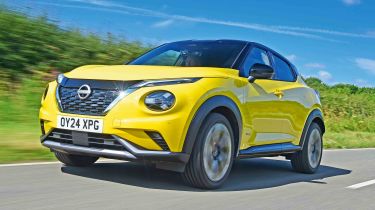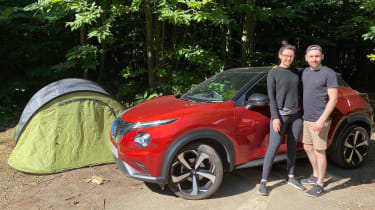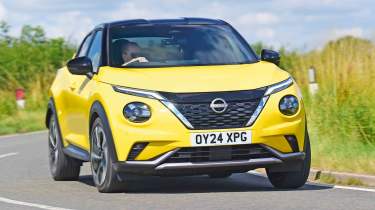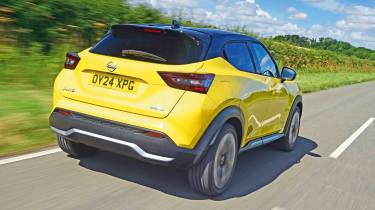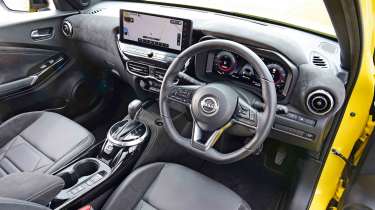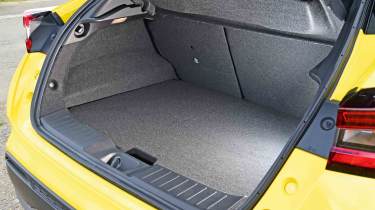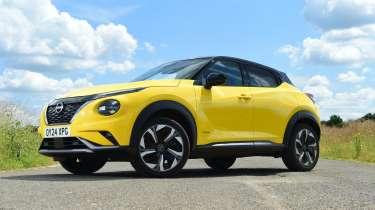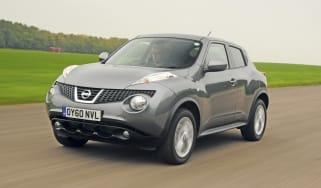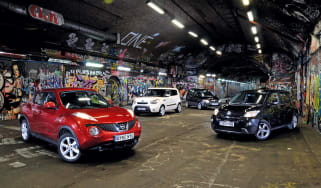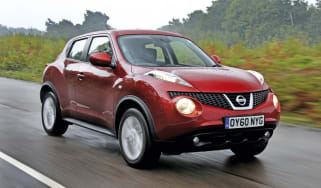Nissan Juke review
Once a trend-setter, the Nissan Juke now plays catch-up to a bunch of rivals it helped to inspire

It took the best part of a decade to replace the Nissan Juke because the original was such a successful concept. But like a band following up with a difficult second album, there was a lot expected of the next-generation Juke when it arrived in 2019, and not just from its loyal fans.
Ever since the first Juke entered the charts, scores of rivals have come along to cash in on its success. Some are more practical, others are more fun to drive. And, of course, a number had gone down the electrification route. In the process of making something that tried to cater to all tastes, the resulting second-generation Juke didn’t quite hit all the right notes, and has since been playing catch-up to some seriously accomplished competition.
| Key specs | |
| Fuel type | Petrol, Hybrid |
| Body style | Small SUV |
| Powertrain |
1.0, 3cyl, turbocharged petrol, front-wheel drive 1.6, 4cyl, petrol plus 1x e-motor, front-wheel drive |
| Safety | 5 star Euro NCAP (2019) |
| Warranty | 3yrs/60,000 miles |
Nissan Juke: model range, specs and rivals
Nissan pretty much invented the small SUV class when it launched the first Juke back in 2010. It offered butch, if slightly caricatured ‘off-road’ styling, a pleasingly elevated view of the road, and looked nothing like the boring old hatchbacks or mini MPVs that cost similar money.
However, it was just as easy to own and drive, and as a result, sales boomed. Rivals naturally pitched in behind the Juke with crossovers of their own, but it took a while for the industry to catch up, and Nissan made hay.
Used - available now
Fast forward to now, and the playing field is littered with small SUV rivals, and while that may be a credit to Nissan’s visionary product planners, it’s a significant challenge for the firm’s engineers. Regrettably, it’s a challenge we find the second-generation Juke, launched in 2019, struggles to meet.
The Juke still features much of what made the original car such a great success – bold styling, compact yet practical dimensions and a high-riding stance and driving position. It’s also 35mm wider and 75mm longer than before, while the wheelbase has grown by 105mm, so there is more interior space.
Under the skin, the Juke shares much with the Renault Captur – the two use the same CMF-B platform, engines and some tech. The Juke is designed in Britain and is built at Nissan’s factory in Sunderland.
Buyers now have the choice of two engines: a 112bhp turbocharged 1.0-litre three-cylinder unit, and a 141bhp 1.6-litre petrol hybrid. The former is available with either a manual or automatic gearbox, while the latter hybrid comes with a ‘multi-modal’ automatic transmission. There’s no four-wheel-drive option, unlike the Toyota Yaris Cross and Volkswagen T-Roc; all Juke models are front-wheel-drive only.
Nissan’s tried-and-tested and rather broad trim level line-up applies: Acenta Premium, N-Connecta, Tekna, Tekna+, and N-Sport versions are available. Both petrol and hybrid power are available across the entire trim line-up, and prices start at around £23,500 for a 1.0-litre Acenta Premium.
The Juke faces a long list of formidable rivals, including the closely related Captur – a car that’s technologically similar, yet has its own appealing combination of style, practicality, comfort and driving enjoyment.
Elsewhere, the likes of the Citroen C3 Aircross, Ford Puma, Honda HR-V and SEAT Arona give the Juke a run for its money in the comfort, practicality and driving involvement stakes, respectively; the Peugeot 2008 has taken the fight upmarket, while the Volkswagen T-Cross has badge power and a wide range of excellent engines on its side. Perhaps the biggest challenge comes in the shape of the Skoda Kamiq – a solid all-rounder that caters to a similarly value-conscious end of the small SUV market.
How much does the Nissan Juke cost?
Nissan Juke prices start from £23,500 and go up to £28,400. The Auto Express network of trusted dealers is currently offering discounts on those recommended retail prices of up to £5,245 via our Find a Car service. Alternatively, you can lease a Nissan Juke from around £191 per month.
Nissan Juke Tekna: long-term test review
Back in 2020, our then News editor Jonathan Burn ran a pre-facelift Nissan Juke for six months. It proved to be a more practical car than its predecessor, with some useful features such as the Nissan ‘curry hook’ for keeping your takeaway upright. Being a Tekna trim car, it had the excellent Bose sound system that helped make up for the lack of live music events during Covid lockdowns.
However, the ride came in for constant criticism from both Jonathan and the wider team, plus the realisation that while the Juke may have been a trendsetter in the small SUV market, there were many more accomplished rivals around that the second generation car couldn’t compete with.
Used and nearly new
When the Nissan Juke made its debut in 2010, it was one of the first models to feature rugged SUV style in a supermini-sized package. Good to drive and featuring low running costs, it was a hit with buyers on a budget who wanted to stand out on the road.
It’s a mark of the Juke’s popularity that the first-generation model lasted nearly a full decade on sale, with only a minor refresh in 2014. It was also the first car of its kind to offer a sportier version, the Nismo and Nismo RS preceding rivals such as the Ford Puma ST by a good few years.
An all-new model arrived in 2019, retaining the original’s style and compact dimensions, but adding a more upmarket feel and much-improved tech.
Nissan Juke history

Nissan Juke Mk2: 2019-present
The latest Juke has a far more premium feel than its predecessor. The bold exterior design now matches a classy and upmarket interior, all while offering greater space. It’s also more grown up to drive, with improved refinement and greater handling precision. It’s also packed with the latest tech, including an upgraded touchscreen infotainment and a raft of advanced driver aids.
Nissan Juke Mk1: 2010-2019
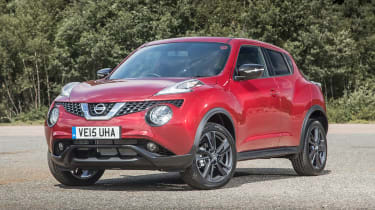
The pioneering Juke set the small SUV template that almost every other manufacturer follows. Its mix of quirky exterior styling, a high-set driving position and low running costs made it an instant sales success. More practical and talented rivals soon muscled in on the Nissan’s patch, but the Juke’s visual appeal meant that it remained a popular choice until its replacement in 2019. You can read our full Nissan Juke used buyer’s guide here.
Engines, performance and drive
While the official line is that the Nissan Juke has been tuned for UK roads, we think it was specifically tested around the roundabout-laden roads of Milton Keynes. For that, the Juke is rather adept thanks to bags of grip and excellent body control that resists body lean well in corners.
The downside is that the suspension has had to be firmed up to ensure the Juke remains level in corners, so the ride quality suffers. Go for a Tekna trim car on 19-inch alloy wheels, and the ride feels fidgety at all speeds, and unfortunately rather unsettled and bouncy at motorway speeds. Such constant movements can become quite tiring, whereas far more supple like the Skoda Kamiq are much suited to long-distance road trips.
Around town, the quick steering of the Juke should make it feel alert and eager, but its keenness to self-centre gives it an unnatural feel that seems odd next to the well-weighted and accurate steering feel of the Ford Puma. It also can’t match that rival’s slick manual gear change, while the pedals in the Juke have an oddly spongy feel that makes it difficult to drive smoothly in traffic. The DCT automatic available with the 1.0-litre engine isn’t much better in this regard, because it’s jerky at slow speeds. On B-roads, you might find it changing down a gear more often than you’d like – especially on steeper inclines.
Buyers will welcome the extra power (and efficiency) of the 1.6-litre petrol hybrid unit. Keep things relaxed, use its EV mode as much as possible, and it’s relatively refined. You can remain in EV mode up to 34mph, before the petrol engine has to cut in, but it is quite coarse when it does so. The automatic gearbox with the hybrid Juke is generally fine if you take things easy, but can be reluctant to change down when you put your foot down when trying to overtake.
The brakes of the regular petrol Juke work well, while the hybrid version utilises a regenerative braking system called e-Pedal that’s borrowed from the brand’s electric car range. It’s a system that allows you to top up the batteries simply by lifting off the accelerator to slow down. With the e-Pedal system switched on, the car will slow very quickly (much more so than most other hybrid cars) without you needing to touch the brake pedal, as the system tries to generate as much electricity as possible to put back into the battery. Once you get the hang of it, you can almost drive the Juke with one pedal.
Both petrol and hybrid versions can suffer quite a bit of road noise – especially on the biggest 19-inch wheels. And despite its sleek body, wind noise from its chunky door mirrors can be an issue at higher speeds.
| Model | Power | 0-62mph | Top speed |
| Juke 1.0 DiG-T 114 | 112bhp | 10.7 seconds | 112mph |
| Juke 1.0 DiG-T 114 DCT | 112bhp | 11.8 seconds | 112mph |
| Juke 1.6 Hybrid | 141bhp | 10.1 seconds | 103mph |
0-62mph acceleration and top speed
The 1.0-litre turbocharged three-cylinder petrol engine puts out 112bhp and 200Nm of torque, which is enough to give it a 0-62mph time of 10.7 seconds (11.8 seconds with the DCT auto), and a top speed of 112mph. The 1.6 Hybrid is a little quicker thanks to its 141bhp and 205Nm of torque, getting to 62mph in 10.1 seconds. Its top speed is slower at 103mph, though.
The standard 1.0-litre petrol pulls the Juke along reasonably well – but only if you keep the revs up. It can feel laggy, especially if you misjudge the revs when trying to pull away, because it takes ages before the turbo kicks in to deliver the sort of punch you need to merge into traffic quickly.
The 141bhp hybrid is the quickest Juke on offer, proving to be swifter than hybrid rivals such as the Hyundai Kona and Toyota Yaris Cross. However, the Juke doesn’t deliver its power as smoothly as those rivals. It’s almost EV-like in its responsiveness away from the lights, but demand more power out on the open road, and the Juke’s hybrid system seems to confuse itself. After an initial burst, there’s a noticeable delay before the combustion engine wakes up rather coarsely.
MPG, CO2 and running costs
Emissions and fuel economy for the 112bhp 1.0-litre model are dictated mainly by gearbox type and wheel size; Nissan quotes up to 48.7mpg for the manual and up to 47.1mpg for the seven-speed dual-clutch automatic, while CO2 starts from 132g/km, with the manual the marginally cleaner option, rising to 138g/km for the auto. While those numbers aren’t bad, the Peugeot 2008 and Skoda Kamiq are cleaner and more frugal options.
The answer to those two rivals is to consider the Juke petrol hybrid, with a combined efficiency of 58.9mpg and emissions of 109g/km. Again, those are fair figures, but rivals such as the Hyundai Kona hybrid and Toyota Yaris Cross are still lower.
If you happen to be a company car driver considering the Juke, you may want to also look at its sibling, the Renault Captur. You can get this as an ultra-low emission plug-in hybrid, which could significantly lower your monthly Benefit-in-Kind (BIK) company car tax bill. Then there are also the all-electric alternatives such as the Hyundai Kona Electric, Peugeot e-2008, and Vauxhall Mokka Electric, because these could help you save even more money.
All models get stop/start as standard, as well as an Eco drive mode that helps save fuel – but you’ll notice a drop in performance as a result.
| Model | MPG | CO2 | Insurance group |
| Juke 1.0 DiG-T 114 (six-speed manual) | 48.7mpg | 133g/km | 13 |
| Juke 1.0 DiG-T (seven-speed auto) | 46.3mpg | 138g/km | 12 |
| Juke 1.6 Hybrid | 58.9mpg | 109g/km | 14 |
Insurance groups
The Juke is unlikely to break the bank in the insurance stakes; the standard petrol model range mostly occupies groups 12 and 13 (out of 50), while the hybrid is a little higher in group 14.
If you need a small SUV that’s even cheaper to insure, both the petrol SEAT Arona and Toyota Yaris Cross sit in lower insurance groups.
Depreciation
Our experts predict that the Juke will retain between 47 to 51 per cent of its original value after three years and 36,000 miles come trade-in time. For context, the closely related Renault Captur performs a little better by maintaining between 52 to 55 per cent, while the Toyota Yaris Cross is likely to hold on to between 48 to 55 per cent over the same period.
To get an accurate valuation for a specific model, check out our valuation tool...
Interior, design and technology
The second-generation Nissan Juke is instantly recognisable as an evolution of the original compact crossover. The car’s slim daytime running lights and oversized headlamps mimic the old version’s, while the pronounced haunches and hidden rear door handles are another nod to the original.
The Juke shares plenty of common parts with its French siblings, the Renault Clio and Renault Captur, because it’s based on the same platform. The Captur is more intelligently packaged, offering a sliding rear bench and up to 536 litres of boot space. Still, there’s much to like about the Nissan’s interior, including a logically laid-out dashboard and lots of adjustment in the driver’s seat.
The Juke may not look as classy as a Skoda Kamiq inside (we didn’t much rate the faux carbon-fibre trim used in our N-Sport test car), but there’s loads of kit, and the dials are easy to read. All models come with a 12.3-inch touchscreen display that’s angled towards the driver by eight degrees and is similar to what we’ve seen on the larger Nissan Ariya. Some physical shortcut buttons are provided along the bottom of the screen to make it easier to use on the move.
If you choose the Tekna trim, you get Nissan’s Advanced Safety Shield. This offers various semi-autonomous features, such as the firm’s Intelligent Around View Monitor, adaptive cruise control, autonomous emergency braking, blind spot monitoring, and rear cross-traffic alert.
Entry-level Acenta Premium features manual air conditioning, cruise control, traffic sign recognition, lane departure warning, high beam assistance, and LED headlights. Mid-range N-Connecta features keyless go, climate control, ambient interior lighting, wireless phone charging, a 12.3-inch digital instrument cluster, and 17-inch alloy wheels.
Tekna and Tekna+ pile on the kit with 19-inch wheels, a Bose stereo and a Heat Pack with heated seats and heated windscreen.
Finally, N-Sport (which costs the same as Tekna+) has the sportiest look with trim-specific black alloy wheels, gloss black exterior trim, and some satin silver trim on the front bumper.
Sat-nav, stereo and infotainment
The revised Juke comes with a 12.3-inch infotainment screen, which is significantly larger than the older eight-inch system. The home screen is customisable, allowing you to display frequently used widgets. The system also features sat-nav, wireless Apple CarPlay and Android Auto smartphone connectivity. Opt for the mid-range N-Connecta and it comes with wireless phone charging to save on trailing charging cables everywhere.
A four-speaker sound system comes as standard on Acenta Premium, with a six-speaker sound system provided with N-Connecta, but we prefer the 10-speaker Bose sound system that comes with Tekna trim and above. This set-up features speakers set into the front headrests, which means you not only get a much clearer sound, but it’s less harmful to your hearing. The quality is excellent, and it works well no matter what kind of music, radio or podcast you like to listen to.
Boot space, comfort & practicality
Despite its myriad specs, there is only one body style to choose from when specifying your Nissan Juke. Every version has five doors, five seats, a decent-sized boot, and a roomy cabin.
The driving position has plenty of adjustment; you sit low, and the steering wheel moves fore and aft, as well as up and down. Visibility is fine out the front, but the small side windows and rear windscreen can make parking more challenging, especially in entry-level Acenta Premium, which only comes with a reversing camera. That might make mid-range N-Connecta worthwhile because it gets front and rear parking sensors, and you can add the Advanced Safety Shield pack as an optional (standard on Tekna and above) to get a 360-degree camera system.
In terms of cabin storage, there are some large door bins and a sizeable glovebox, but the cubby between the front seats is only just big enough for a modern smartphone, and the small area ahead of the gearlever isn’t very useful. In the back, there is a pair of door bins big enough for a 500ml bottle of water.
| Dimensions | |
| Length | 4,135mm |
| Width | 1,765mm |
| Height | 1,565mm |
| Number of seats | 5 |
| Boot space | 354-litres |
Size
The second-generation Nissan Juke is 35mm wider and 75mm longer than the original, and it certainly looks more imposing on the road thanks to its raised haunches and bulbous front end. However, at 4,210mm long, it’s slightly shorter than a Skoda Kamiq.
Leg room, head room & passenger space
The sloping roofline of the Juke means it feels pretty dark in the back seats, plus the small windows might bother children wishing to look outside on longer trips. Adults under six-foot should be able to get comfortable, although those over six-foot will have a much easier time in the practically palatial Kamiq.
Two rear ISOFIX child seat points are included as standard in the Juke, which helps when travelling with younger passengers in car seats. All versions feature two USB charging sockets for those in the back seat to top up their smartphone or tablet.
Boot space
The Nissan Juke’s 422-litre boot is much bigger than before, and sizes up well in this class. However, the hybrid version has a smaller 354-litre (350 litres with the Bose sound system) boot due to parts of the hybrid system taking up space, and the Juke doesn’t get a sliding rear bench seat like its Renault Captur, which allows you to increase the available boot capacity at the expense of rear leg room.
The back seats do fold down to reveal a 1,305-litre space (1,237 litres for the hybrid, or 1,114 litres for a Hybrid version with the Bose speakers) which should be enough for most jobs, although the Kamiq offers an even greater 1,395-litre total capacity.
Worth noting is the Juke’s boot opening, which is wider than before, but isn’t as generous as the Volkswagen T-Roc, making it harder to load larger items into the boot. The boot floor is adjustable for height; you’ll sacrifice some space in its highest setting, but the flip side is that you won’t have to contend with any kind of nasty load lip.
The fixed parcel shelf attaches to the boot lid via a pair of strings and lifts out easily, although it feels super-flimsy, and there’s nowhere to store it. Nevertheless, there’s enough space for a road bike in the back.
Towing
The 112bhp petrol model has a maximum braked trailer weight of 1,250kg, while the hybrid version is rated to tow a braked trailer with a total 750kg load.
For maximum towing capacity in a small SUV, look at the four-wheel drive ‘4Motion’ VW T-Roc, because that can tow up to 1700kg in both 2.0-litre petrol and diesel forms.
Reliability and safety
The Nissan Juke is a thoroughly modern small SUV offered with an array of active safety and driver assistance systems: all models get an emergency call system, cruise control with speed limiter, automatic emergency braking (AEB), lane-departure warning and traffic-sign recognition.
The optional Advanced Safety Shield pack on N-Connecta (standard on Tekna models and above) adds traffic jam and lane-keep assist, adaptive cruise control, driver-alertness monitoring, blind spot warning and intervention, and rear cross-traffic alert. It is a shame adaptive cruise and blind spot warning aren’t standard, though, like they are on every version of the Volkswagen T-Cross.
The Juke received a middling score of 28th out of 50 in the 2024 Driver Power customer satisfaction survey, ahead of the Vauxhall Mokka (34th) and VW T-Roc (35th), but behind the SEAT Arona (26th) and Ford Puma (10th).
Nissan, as a brand, came in 15th place out of 32 manufacturers in the same survey. That puts it ahead of Skoda, SEAT, Vauxhall, VW, Ford, and Renault, but behind rivals Toyota, Peugeot, and Kia.
| Key standard safety features | Euro NCAP ratings |
|
Warranty
All Nissan models are covered by a three-year, 60,000-mile warranty that’s a match for the identical warranties offered by Ford, Skoda and Volkswagen, among others. The five-year, unlimited-mileage warranty from Hyundai is still among the best, followed by Kia with its seven-year, 100,000-mile offering. Then there is the 10-year or 100,000-mile policy offered by Toyota – although you will have to keep getting your car serviced annually at a Toyota main dealer to maintain the warranty over that extended period.
Servicing
Service intervals are scheduled every 18,000 miles or 12 months for both the 1.0-litre petrol and 1.6 hybrid models, whichever comes first. Flexible monthly payment plans are available for around £20 per month, covering servicing costs for the next two, three or four services.
Should you buy a Nissan Juke?
The Nissan Juke would suit those who think most small SUVs look the same, and who value long equipment lists. There’s also something to be said about how the Juke continues to use physical controls for many functions, whereas an increasing number of its rivals have gone to touch-sensitive or touchscreen controls only, both of which can be hard to use on the move.
However, the Juke still has a firm ride, and isn’t as comfortable as a Skoda Kamiq, nor is it as efficient as certain petrol rivals like the Peugeot 2008, or hybrid ones like the Toyota Yaris Cross.
But perhaps the biggest drawback is that the cheaper Renault Captur can be had with its versatile sliding rear seat. This enables the Captur to be more flexible than the Juke by providing either a bigger boot or greater rear passenger space, depending upon your needs at the time
